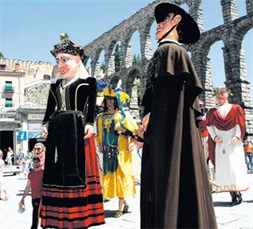The Giants of Segovia
 The Giants of SegoviaOf ancient origins, Segovia was an important center of Roman Spain. After the Arab domination, from the thirteenth to the fifteenth century, the King of Castile resided in Segovia. The transfer of the capital to Toledo, and the failure of the revolt of the comuneros, in which Segovia took part along with other Castilian cities to protest against the policies of the Emperor Charles V, caused its decline. Today it is famous worldwide for its impressive Roman aqueduct. have paraded for at least four centuries during the procession of Corpus Christi. Already at the beginning of the seventeenth century, the historical sources attest to the presence of four pairs of giants composed of a giant and a giantess: Gypsies, Negroes, Spaniards and Turks. They are huge puppets made of a wooden framework covered with light cloth. Skilled carriers made them dance during the sacred parade, in which two gigantillas took part: the famous dwarfs which have huge heads, now more known as cabezudos (big heads). The parade was opened by the Tarasca: an intriguing mythological monster surmounted or accompanied by small puppets called Tarasquillas. Present in many Spanish cities such as Barcelona and Redondela and also widespread in the south of France, the Tarasca is a bizarre zoomorphic hybrid, which is also mentioned in the Golden Legend. The task of embodying evil and the enemies of the faith is assigned to it, a role it shares with the famous giant Goliath, of which at one time in Segovia and in many other places in Europe they used to stage the killing at the hands of a small and valiant David. Between the seventeenth and twentieth century the Giants of Segovia have undergone various transformations, both in their physical appearance as in their identity and the role that they once had during the city’s holidays, a fate shared with their European counterparts. Some are gone, such as the Tarasca, others have changed in appearance: all, in any case, now represent something different than their ancestors. This transformation has been especially been determined by the departure of the Giants from the festive context in which they were born: the procession of Corpus Christi. Today, in fact, the giants of Segovia parade during the celebrations of Saint John and Saint Peter’s (24 and 29 June). Almost four meters tall and weighing more or less than half a ton, the Gigantones of today, accompanied by their wives, are the Alcalde (Mayor), the American, the African, the Asian and Oceanian. Where once the giants of Segovia depicted the submission of all mankind to God, today they are mainly a symbol of the town. This is evinced by the prominent role assumed by the Alcalde and his wife.
The Giants of SegoviaOf ancient origins, Segovia was an important center of Roman Spain. After the Arab domination, from the thirteenth to the fifteenth century, the King of Castile resided in Segovia. The transfer of the capital to Toledo, and the failure of the revolt of the comuneros, in which Segovia took part along with other Castilian cities to protest against the policies of the Emperor Charles V, caused its decline. Today it is famous worldwide for its impressive Roman aqueduct. have paraded for at least four centuries during the procession of Corpus Christi. Already at the beginning of the seventeenth century, the historical sources attest to the presence of four pairs of giants composed of a giant and a giantess: Gypsies, Negroes, Spaniards and Turks. They are huge puppets made of a wooden framework covered with light cloth. Skilled carriers made them dance during the sacred parade, in which two gigantillas took part: the famous dwarfs which have huge heads, now more known as cabezudos (big heads). The parade was opened by the Tarasca: an intriguing mythological monster surmounted or accompanied by small puppets called Tarasquillas. Present in many Spanish cities such as Barcelona and Redondela and also widespread in the south of France, the Tarasca is a bizarre zoomorphic hybrid, which is also mentioned in the Golden Legend. The task of embodying evil and the enemies of the faith is assigned to it, a role it shares with the famous giant Goliath, of which at one time in Segovia and in many other places in Europe they used to stage the killing at the hands of a small and valiant David. Between the seventeenth and twentieth century the Giants of Segovia have undergone various transformations, both in their physical appearance as in their identity and the role that they once had during the city’s holidays, a fate shared with their European counterparts. Some are gone, such as the Tarasca, others have changed in appearance: all, in any case, now represent something different than their ancestors. This transformation has been especially been determined by the departure of the Giants from the festive context in which they were born: the procession of Corpus Christi. Today, in fact, the giants of Segovia parade during the celebrations of Saint John and Saint Peter’s (24 and 29 June). Almost four meters tall and weighing more or less than half a ton, the Gigantones of today, accompanied by their wives, are the Alcalde (Mayor), the American, the African, the Asian and Oceanian. Where once the giants of Segovia depicted the submission of all mankind to God, today they are mainly a symbol of the town. This is evinced by the prominent role assumed by the Alcalde and his wife.
